Through the Windows 8, Darkly
Windows 8 is coming and the changes are going to be enormous. The user interface gets a complete makeover and there's a good chance that a lot of people will dislike it without even giving in a chance. Microsoft software engineer and blogger Steven Sinofsky (who also happens to head the project) has written about something that seems trivial—basic file management (copy, move, rename, and delete). Fundamental, yes. But not really trivial. When you're using a computer, you'll almost always be working with files. Improvements at this level affect every application on the computer.
Sinofsky says "Usability studies confirm there are some cluttered and confusing parts of the Windows 7 copy experience. This is particularly true when people need to deal with files and folders that have the same file names, in what we call file name collisions." And surprisingly, he says that more than 5% of simple file copy jobs fail to complete for various reasons.
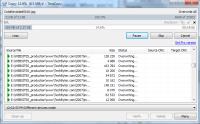 Windows Explorer is not and never has been an application that deals effectively with high-volume copy operations. I use an application called TeraCopy to help with large copy jobs. This is one of the top three third-party copy management tools. The other two are FastCopy and Copy Handler. But only a few users know about these utilities. Microsoft's telemetry tools show that these applications are installed on about half of one percent of Windows 7 computers.
Windows Explorer is not and never has been an application that deals effectively with high-volume copy operations. I use an application called TeraCopy to help with large copy jobs. This is one of the top three third-party copy management tools. The other two are FastCopy and Copy Handler. But only a few users know about these utilities. Microsoft's telemetry tools show that these applications are installed on about half of one percent of Windows 7 computers.
If you ever need to copy large numbers of files and you're frustrated by the amount of time it takes, check out one of the following free (for home use) utility programs.
TeraCopy: Click here to download TeraCopy.
FastCopy: Click here to download FastCopy.
Copy Handler: Click here to download Copy Handler.
Sinofsky says that Microsoft isn't trying to match the feature sets of these add-ons. We expect that there will be a vibrant market for third-party add-ons for a long time. Our focus is on improving the experience of the person who is doing high-volume copying with Explorer today, who would like more control, more insight into what’s going on while copying, and a cleaner, more streamlined experience.
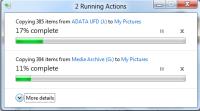 Have you ever started a second copy job before the first job completed? You then had 2 copy dialogs on the screen and there was no relationship between the two. If you do that in Windows 8, you'll see 2 progress bars in the same dialog box.
Have you ever started a second copy job before the first job completed? You then had 2 copy dialogs on the screen and there was no relationship between the two. If you do that in Windows 8, you'll see 2 progress bars in the same dialog box.
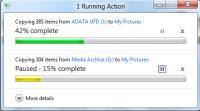 What if your daughter needs to leave soon and you want the copy job that involves her DVD to finish before the copy job that involves the USB memory stick with pictures from your vacation? Easy! Just pause the vacation job. In Windows 8 users will be able to pause, resume, and stop each copy operation currently underway.
What if your daughter needs to leave soon and you want the copy job that involves her DVD to finish before the copy job that involves the USB memory stick with pictures from your vacation? Easy! Just pause the vacation job. In Windows 8 users will be able to pause, resume, and stop each copy operation currently underway.
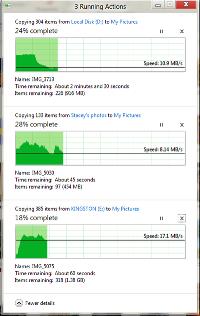 Windows 8 will add a detailed view with a real-time throughput graph. So each copy job will show the speed of data transfer, the transfer rate trend, and how much data is left to transfer. While this is not designed for benchmarking, in many cases it can provide a quick and easy way to assess what is going on for a particular job.
Windows 8 will add a detailed view with a real-time throughput graph. So each copy job will show the speed of data transfer, the transfer rate trend, and how much data is left to transfer. While this is not designed for benchmarking, in many cases it can provide a quick and easy way to assess what is going on for a particular job.
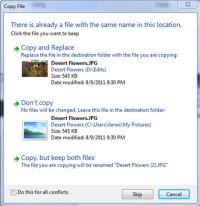 The current file-collision dialog is better than anything Microsoft has offered before but it's still confusing. This is what you're used to seeing.
The current file-collision dialog is better than anything Microsoft has offered before but it's still confusing. This is what you're used to seeing.
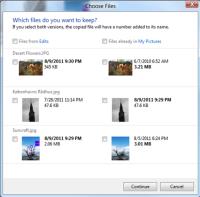 Windows 8 will present all file collisions in a single dialog.
Windows 8 will present all file collisions in a single dialog.
Anyone who has ever copied a file has probably seen an estimated completion time dialog that said the job would take 59 days, then 30 days, 24 hours, and (a few seconds later) 40 seconds. There are good reasons for the inaccuracy (How much network bandwidth will be available for the length of the copy job? Will your anti-virus software spin up and start scanning files? Will another application need to access the hard drive? Will the user start another copy job?) but still it's hard to reconcile the quick change from many weeks to just a few seconds.
Sinofsky says that rather than invest a lot of time coming up with a low-confidence estimate that would be only slightly improved over the current one, in Windows 8 Microsoft's software engineers focused on presenting the information we were confident about in a useful and compelling way. "This makes the most reliable information we have available to you," he says, "so you can make more informed decisions."
Carousel—Adobe Brings Back the Name
Once upon a time, Kodak make a slide projector called a Carousel. It was invented by Louis Misuraca, who came to the United States from Italy when he was a child. For inventing the carousel, Misuraca earned no royalties. Kodak paid him a one-time fee and it's said that he used the money to take his family on a trip to Italy. Carousel projectors use a circular tray that held 80 or 140 35mm slides. Kodak discontinued projectors in 2004 but now Adobe has resurrected the name for a new online service.
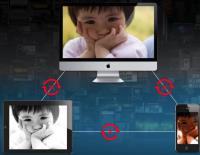 Carousel attempts to address the difficulty of sharing images among users who have disparate computing devices. Currently it is available only to users of Apple Ipads, Iphones, and Mac computers but will be available for Windows users and Android phones in 2012. It also supports only JPG images currently but support for raw images is under consideration for for a future version of the application. Those who shoot only raw images must convert the images to JPG before sharing them via Carousel.
Carousel attempts to address the difficulty of sharing images among users who have disparate computing devices. Currently it is available only to users of Apple Ipads, Iphones, and Mac computers but will be available for Windows users and Android phones in 2012. It also supports only JPG images currently but support for raw images is under consideration for for a future version of the application. Those who shoot only raw images must convert the images to JPG before sharing them via Carousel.
It's probably fair to consider this version 1.0 product a good proof of concept but until it's available for Windows and Android users, and until it can deal seamlessly with raw images, it doesn't seem like a game changer for photo sharing. Those who shoot raw images will still have to convert them to JPG format and upload them. Changes made to the JPG images will not be reported back to the raw files. But it's a good and ambitious start.
Carousel's intent is to make all photos available to all users on all devices. "All" might be a bit of an overstatement, though. Those who sign up for the program ($60 per year or $6 per month) will have 5 carousels and each carousel may be shared with up to 5 people. Any given carousel can contain any number of images, though.
Adobe's intent with this new application is to allow users to share, browse, and adjust photos on all supported devices. Unfortunately, those devices now are just Mac computers and applications that run IOS (Ipad and Iphone).
Carousel offers "looks" that can reasonably be thought of as filters but users also have access to more precise controls such as automatic white balance, manual white balance, highlight and shadow controls, contrast, clarity, and vibrance.
As with Adobe's Lightroom product, all changes are non-destructive. That means that the modifications are stored in a description file and the user can always revert to the original JPG image.
Carousel promises to be an application that will change, once again, how we use and share photography.
Questions and Answers: E-mail
A discussion of e-mail turned to spam and rejected messages. They are closely related subjects. The discussion covered several useful topics and I asked the participants for their permission to use their words.
One participant, who I will call Donna (because that's her name), said, "Even with our own domains, aren't we still somewhat at the mercy of the hosts?"
Yes. Nothing is foolproof. Even the US Postal Service occasionally delays, damages, or loses some messages.
Donna: "My uncle has his own domain. I send e-mail to uncle@hisdomain.com (from my primary address when it went through BlueHost, before I moved it to Google Apps, as well as from several of my @gmail.com addresses), and it gets bounced back to me, with various and seemingly random explanations for why it happened."
Here's one reason: BlueHost is a shared hosting service. They host at least tens of thousands of domains, probably hundreds of thousands by now. My domain (techbyter.com) lives at 69.89.31.245. At least 174 other domains share that IP address. If you take into account the subdomains (such as blogs.example.com) that also reside on the server, the total reaches nearly 1000.
That matters because the Internet's spam vigilantes (the ones who create blacklists used to determine which messages to block) do not list domain names because those can easily be forged. They list IP addresses. BlueHost reacts quickly when it finds spammers on its systems. Under its terms of service (TOS) it can immediately terminate the account of a spammer and it does. But mail from every other domain that shares the IP address will be blocked for some period (I believe it's 72 hours for most blacklists).
There are two ways to avoid this problem:
- Ask the hosting service to provide an IP address that only you use. Most hosts can do this and the cost is typically $25 to $100 per year (BlueHost charges $30).
- Use your ISP's SMTP server to send mail and your own domain to receive mail. This is a trivial process with an e-mail application such as The Bat. I presume it can be done with other client apps.
Donna: "Sorting through the header shows that it goes through Comcast at some point. I didn't spend more than five minutes trying to sort his problem out, but I'm assuming Comcast is his host (I do know that it's his ISP)? Or his host rents space from Comcast for e-mail traffic?"
Many ISPs provide space for website hosting, sometimes for free and sometimes for a fee. I have set up websites on systems such as these and feel that even the free services are overpriced.
Donna: "While I think having your own domain is a good idea (but whether you have one or not is not going to keep me up at night), my uncle's experience was that having one doesn't guarantee you'll get all of your e-mail. Until one of my messages bounced, he had no idea that was happening."
The sender should always be advised when a message is not delivered. (Note my use of the weasel word "should".) In practice, it doesn't some ISPs simply delete messages without telling anyone. I keep hoping that's a lawsuit waiting to happen but it keeps waiting.
Another participant, Deborah, said, "Even when I get my own domain, I'll still post my ISP address to public lists. I hate spam that much, and I don't want it coming to my domain address if I can help it."
Wouldn't a better way be simply to control the spam? Web hosting companies provide a variety of defenses. BlueHost, for example, will enable Postini (a Google product) for $12 per year per address. I tried it for a while and both my wife and I found it to be far more trouble than it was worth.
Then I went back to my old method: I re-enabled the antique SpamAssassin, which rates messages on a variety of criteria and marks as spam any message that exceeds a rating that I set.
This means that inbound spam suspects are marked and they go directly to a spam folder. I could simply delete the suspects but occasionally a message that I want to see will be classified spam. (And occasionally I go through the refuse to write an article for TechByter.)
I also use a second line of defense, a plug-in for The Bat (AntiSpam Sniper) that catches the occasional spam that gets past SpamAssassin.
Norton Internet Security also has a spam identification routine that I leave enabled.
In the past few hours, I've received just 37 spams. Most of them came to bill.blinn@techbyter.com, a high-profile address that I advertise freely on TechByter.
- Of those 37 messages, SpamAssasin identified all but 12. I set SpamAssassin's threshhold very high because I prefer to let in anything that might possibly be legitimate.
- Norton and AntiSpam Sniper identified 11 of the remaining 12.
- AntiSpam Sniper alone identified the 12th.
- Not one actual spam reached my inbox. Not one genuine message was marked as spam.
Deborah: "I suppose one solution would be formatting it on the list with @ spelled out."
No, it wouldn't. Spammers know that trick.
Deborah: "I have another address [with a big ISP. The] address, which has its ... spam filters disabled, loses some incoming messages in the ozone. This has happened maybe five times in the past year that I know of, and I have to wonder how many times it's happened that I don't know about. [The big ISP] pleads complete ignorance."
As will any ISP.
If you want to find out which domains share your IP address, here are some resources:
sameip.org (may not be current)
pagesinventory.com (includes inbound and outbound link count)
myipneighbors.com (first 10 domains are listed for free; $67.95 for the rest)
myiptest.com (an SQL error occurred on both domain name and IP)
Short Circuits
Farewell to Michael Hart
Some people make a difference and Michael Hart is likely to be remembered as someone who did make a difference. During the Viet Nam War, he served in Korea. The 64-year-old resident of Urbana, Illinois, and native of Tacoma, Washington, invented the electronic book. In 1971.
Hart had received a free copy of the US Declaration of Independence and that led to his founding of Project Gutenberg, which currently offers over 36,000 free e-books to download to your PC, Kindle, Android, iOS, or other portable device. Free as in "free speech" but also as in "free beer".
This week Hart died.
According to the Project Gutenberg website, "A lifetime intellectual, Hart was inspired by his parents, both professors at the University of Illinois, to seek truth and to question authority. One of his favorite recent quotes, credited to George Bernard Shaw, is characteristic of his approach to life: Reasonable people adapt themselves to the world. Unreasonable people attempt to adapt the world to themselves. All progress, therefore, depends on unreasonable people. Michael prided himself on being unreasonable, and only in the later years of life did he mellow sufficiently to occasionally refrain from debate. Yet, his passion for life, and all the things in it, never abated."
Dr. Gregory Newby quoted something Hart wrote earlier this year and that summarizes his goals and his legacy, "One thing about eBooks that most people haven't thought much is that eBooks are the very first thing that we're all able to have as much as we want other than air. Think about that for a moment and you realize we are in the right job."
Yahoo Shoots Itself in the Foot. Again.
Here's a classy way for the chairman of the board to fire the CEO: Do it by phone. I suppose he could have just sent an e-mail, an IM, or done it in 140 characters on Twitter. Sixty-two-year-old Carol Bartz, the former CEO of AutoDesk (the CAD company) had more than a year on her contract with Yahoo.
Yahoo's board of destroyers -- ah, board of directors -- turned down an offer by Microsoft to buy the company several years ago. At the time, the company was slipping and Microsoft was offering a lot more than Yahoo was worth. Now there are rumors that the board would be willing to sell what's left of the company but it doesn't look like anyone is interested.
Bartz had been CEO for 2 years. She will be succeeded by chief financial officer Tim Morse while the board looks for someone foolish enough to accept the job as Yahoo continues it rush toward irrelevancy.
Desktop Drives: 4TB Now Available
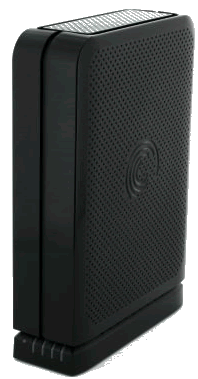 Two days after I ordered a 3TB Seagate GoFlex disk drive for backing up files from home ($135) Seagate has announced the availability of 4TB drives ($250 MSRP). Given the price difference ($115 for that 4th terabyte) I would still have selected the 3TB drive but this is just another example of how quickly storage is expanding and becoming less expensive.
Two days after I ordered a 3TB Seagate GoFlex disk drive for backing up files from home ($135) Seagate has announced the availability of 4TB drives ($250 MSRP). Given the price difference ($115 for that 4th terabyte) I would still have selected the 3TB drive but this is just another example of how quickly storage is expanding and becoming less expensive.
At 4TB, this is the highest capacity individual hard drive in the industry. Seagate says the drive has a smaller footprint and better reflects the "aesthetic of today’s modern offices". If you want to buy one today, you'll have to buy it from Seagate but several online retailers will have it in stock by the end of the month. For Apple users, a Mac version will include both FireWire 800 and USB 2. Windows users will enjoy the much faster USB 3 if their computers support the new USB standard.
In case you wondered, Seagate says 4TB is enough to hold 1.2 million photos, 1,000 full-length movies, or more than 60 thousand hours of music.
September 11, 2001
Because TechByter Worldwide is a program about technology, any commentary on the terrorist attacks of ten years ago seems out of place. But not to acknowledge those events seems equally out of place. So what I have to offer on the subject is merely my own personal commentary.
Ten years ago on September 11 I was in Boston and just about to start my 9am Tuesday program as a speaker at Corel World. Someone who came into the room mentioned that the World Trade Center had been bombed. "Not again!" I said and went on with the presentation. Forty-five minutes later we learned that it wasn't a bomb but an airplane. Two of them. Then one in Washington. And a crash in Pennsylvania.
Stunned, we watched TV monitors that were brought in. My wife called. My older daughter called. "Is this the beginning of World War III?" she asked. I said it wasn't but it turns out that she was more on the mark than I was. It just wasn't what I envisioned as World War III. What we have is more like the never-ending wars in Nineteen Eighty-Four: "We've always been at war with Eastasia" or "We've always been at war with Eurasia" and apparently we always will be.
Ten years ago Corel World continued because nobody could leave. But because nobody could arrive, either, presenters who were due to arrive for programs on Wednesday, Thursday, or Friday couldn't. Those of us who were there pitched in and picked up the topics we were most familiar with.
On Saturday morning, my flight was one of the first to depart Logan Airport.
For those who were directly affected, everything changed that day. For most of the rest of us, that day is now mainly a distant memory. That's the way we humans work. Something terrible happens. We grieve. And eventually we move on.
But we never entirely forget, either.
PBS created, in 1999, a 14-hour program narrated by David Ogden Stiers that explains the past and present of New York City. If you are a Netflix subscriber or if your library has access to this series, I highly recommend watching. Later, an additional 2-hour program was added to discuss the design and building of the World Trade Center and its destruction in 2001. So watching the full program will consume 16 hours.
- New York (at Netflix)
- New York (library) This is a link to Worthington's library; your library may have the same series.
The attack was instrumental in killing PC Expo, a large computer program that annually filled Javits Convention Center but the event was already showing signs of stress from the bursting of the Internet bubble (or dot.com bubble) in 2000. The 2001 show was considerably smaller than in previous years and the 2002 show, the last, was a shadow of its former self.


 The author's image: It's that photo over at the right. This explains why TechByter Worldwide was never on television, doesn't it?
The author's image: It's that photo over at the right. This explains why TechByter Worldwide was never on television, doesn't it?
